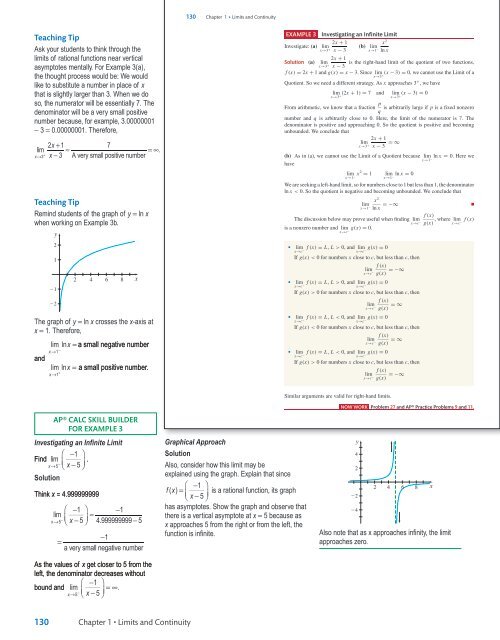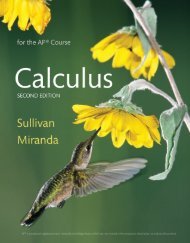Sullivan Microsite TE SAMPLE
Create successful ePaper yourself
Turn your PDF publications into a flip-book with our unique Google optimized e-Paper software.
<strong>Sullivan</strong> AP˙<strong>Sullivan</strong>˙Chapter01 October 8, 2016 17:4<br />
<strong>Sullivan</strong><br />
130 Chapter 1 • Limits and Continuity<br />
Teaching Tip<br />
Ask your students to think through the<br />
limits of rational functions near vertical<br />
asymptotes mentally. For Example 3(a),<br />
the thought process would be: We would<br />
like to substitute a number in place of x<br />
that is slightly larger than 3. When we do<br />
so, the numerator will be essentially 7. The<br />
denominator will be a very small positive<br />
number because, for example, 3.00000001<br />
− 3 = 0.00000001. Therefore,<br />
x<br />
lim 2 + 1<br />
7<br />
.<br />
x − 3<br />
≈ A very small positive number<br />
=∞<br />
→ +<br />
x 3<br />
Teaching Tip<br />
Remind students of the graph of y = ln x<br />
when working on Example 3b.<br />
y<br />
The graph of y = ln x crosses the x-axis at<br />
x = 1. Therefore,<br />
and<br />
2<br />
1<br />
21<br />
22<br />
lim lnx<br />
= a small negative number<br />
x→1<br />
−<br />
lim lnx<br />
= a small positive number.<br />
x→ 1<br />
+<br />
2 4 6 8 x<br />
EXAMPLE 3<br />
Investigate: (a)<br />
Investigating an Infinite Limit<br />
2x + 1<br />
lim<br />
x→3 + x − 3<br />
(b)<br />
x 2<br />
lim<br />
x→1 − ln x<br />
2x + 1<br />
Solution (a) lim is the right-hand limit of the quotient of two functions,<br />
x→3 + x − 3<br />
f (x) = 2x + 1 and g(x) = x − 3. Since lim<br />
x→3 +(x<br />
− 3) = 0, we cannot use the Limit of a<br />
Quotient. So we need a different strategy. As x approaches 3 + , we have<br />
lim<br />
x→3<br />
+(2x<br />
+ 1) = 7 and lim<br />
+(x<br />
− 3) = 0<br />
From arithmetic, we know that a fraction p is arbitrarily large if p is a fixed nonzero<br />
q<br />
number and q is arbitrarily close to 0. Here, the limit of the numerator is 7. The<br />
denominator is positive and approaching 0. So the quotient is positive and becoming<br />
unbounded. We conclude that<br />
2x + 1<br />
lim<br />
x→3 + x − 3 =∞<br />
(b) As in (a), we cannot use the Limit of a Quotient because lim ln x = 0. Here we<br />
x→1− have<br />
lim x 2 = 1 lim ln x = 0<br />
x→1 − x→1 −<br />
We are seeking a left-hand limit, so for numbers close to 1 but less than 1, the denominator<br />
ln x < 0. So the quotient is negative and becoming unbounded. We conclude that<br />
x 2<br />
lim<br />
x→1 − ln x = −∞<br />
■<br />
x→3<br />
The discussion below may prove useful when finding lim<br />
x→c −<br />
is a nonzero number and lim g(x) = 0.<br />
x→c− • lim f (x) = L, L > 0, and lim g(x) = 0<br />
x→c −<br />
x→c −<br />
If g(x) 0, and lim g(x) = 0<br />
x→c −<br />
x→c −<br />
If g(x) >0 for numbers x close to c, but less than c, then<br />
f (x)<br />
lim<br />
x→c − g(x) =∞<br />
• lim f (x) = L, L < 0, and lim g(x) = 0<br />
x→c −<br />
x→c −<br />
If g(x) 0 for numbers x close to c, but less than c, then<br />
f (x)<br />
lim<br />
x→c − g(x) = −∞<br />
f (x)<br />
, where lim<br />
g(x) f (x)<br />
x→c −<br />
Similar arguments are valid for right-hand limits.<br />
NOW WORK Problem 27 and AP® Practice Problems 9 and 11.<br />
AP® CaLC skill builder<br />
for example 3<br />
Investigating an Infinite Limit<br />
⎛ −1<br />
⎞<br />
Find lim<br />
⎝<br />
⎜ − ⎠<br />
⎟ .<br />
x→5<br />
− x 5<br />
Solution<br />
Think x ≈ 4.999999999<br />
⎛ −1<br />
⎞<br />
⎝<br />
⎜ − ⎠<br />
⎟ ≈ −1<br />
lim<br />
→ − x 5 4.999999999 − 5<br />
x 5<br />
−1<br />
=<br />
a very small negative number<br />
As the values of x get closer to 5 from the<br />
left, the denominator decreases without<br />
⎛ −1<br />
⎞<br />
bound and lim<br />
⎝<br />
⎜ − ⎠<br />
⎟ =∞ .<br />
x→5<br />
− x 5<br />
Graphical Approach<br />
Solution<br />
Also, consider how this limit may be<br />
explained using the graph. Explain that since<br />
⎛ −1<br />
⎞<br />
fx ( ) =<br />
⎝<br />
⎜ x − 5⎠<br />
⎟ is a rational function, its graph<br />
has asymptotes. Show the graph and observe that<br />
there is a vertical asymptote at x = 5 because as<br />
x approaches 5 from the right or from the left, the<br />
function is infinite.<br />
y<br />
4<br />
2<br />
22<br />
24<br />
2 4 6 8<br />
Also note that as x approaches infinity, the limit<br />
approaches zero.<br />
x<br />
130<br />
Chapter 1 • Limits and Continuity<br />
<strong>TE</strong>_<strong>Sullivan</strong>_Chapter01_PART II.indd 13<br />
11/01/17 9:55 am




